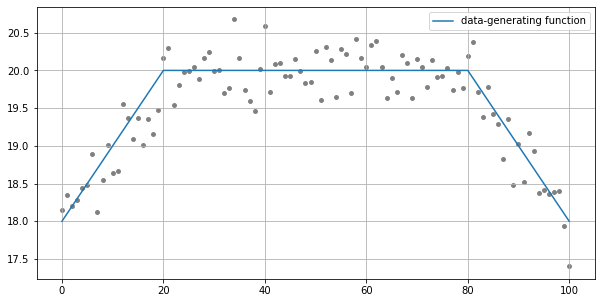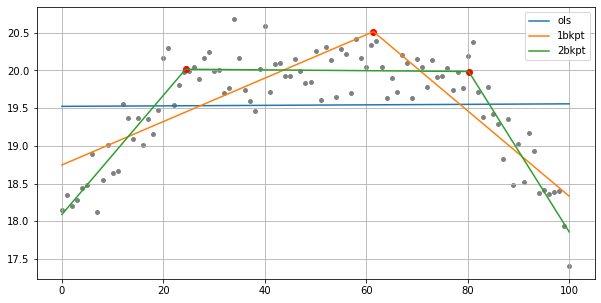Segreg Example All Models¶
[1]:
from matplotlib import pyplot as plt
import matplotlib
import numpy as np
from numpy.random import default_rng
from segreg import analysis
from segreg.model import OLSRegressionEstimator
from segreg.model import OneBkptSegRegEstimator
from segreg.model import TwoBkptSegRegEstimator
[2]:
matplotlib.rcParams['legend.numpoints'] = 1
matplotlib.rcParams['figure.figsize'] = (10,5)
matplotlib.rcParams['axes.grid'] = True
Create a Dataset Based on a Two-Bkpt Function¶
[3]:
two_bkpt_truth_params = [20, 20, 80, 20, 0.1, -0.1]
truth_func = TwoBkptSegRegEstimator().get_func_for_params(two_bkpt_truth_params)
indep = np.arange(101)
seed = 65434789
rng = default_rng(seed)
dep = truth_func(indep) + 0.3 * rng.standard_normal(len(indep))
plt.scatter(indep, dep, s=15, color="gray");
plt.plot(indep, truth_func(indep));
plt.legend(["data-generating function"]);

Estimate All Models¶
[4]:
ols_estimator = OLSRegressionEstimator()
one_bkpt_estimator = OneBkptSegRegEstimator()
two_bkpt_estimator = TwoBkptSegRegEstimator()
estimators = [ols_estimator,
one_bkpt_estimator,
two_bkpt_estimator]
for estimator in estimators:
estimator.fit(indep, dep)
Plot the Fits¶
[5]:
func_arr = [estimator.model_function for estimator in estimators]
u = one_bkpt_estimator.params[0]
u1, u2 = two_bkpt_estimator.params[[0,2]]
extra_pts_arr = [None, [u], [u1, u2]]
analysis.plot_models(func_arr=func_arr,
indep=indep,
dep=dep,
extra_pts_arr=extra_pts_arr,
mark_extra_pts=True,
scatter_size=15,
scatter_color="gray",
marker="o",
legend=["ols", "1bkpt", "2bkpt"]);
